|
Ozona and Palm Harbor, on the coast just north of Dunedin, have interesting histories. Both Ozona and Palm Harbor were originally settled by J.C. Craver. According to Craver's diary, still in the family, he came here in the winter of 1877 upon the advice of his physician. A post office commission under the name of Bay St. Joseph was granted in 1878, this being the earliest written record of either community. The name Bay St. Joseph was used only a short time before Yellow Bluff replaced it. But that name proved relatively short-lived, as a few years later its negative connotation with the yellow fever epidemic gave way to its present name Ozona , meaning "pure air." Palm Harbor was originally called Sutherland after a post office was granted in 1888, the same year the railroad came through (the name was switched to Palm Harbor in 1925 - Editor). Sutherland boasted two beautiful hotels, the larger one becoming Southern College in 1902. It sat high on the bluff overlooking Sutherland Bayou and the Gulf of Mexico. Sutherland was thought to be named after Duke of Sutherland, who visited these parts after landing at Tarpon Springs in 1887. Local pioneers dismiss this coincidence, pointing out that the name Sutherland is a shortening of Southern Land and Development Company, the group which originally platted the community in 1888. Areas pioneers included the Whitehursts, the Hollands, the Tinneys, the Suttons, the Thompsons, and the Wilsons. by Michael L. Sanders 1983 ISBN: 0-89865-401-7 |
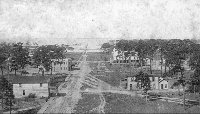
View of Hog Island from the cupola of the Hotel San Marino.
Again a veiw of Sutherland can be seen in this photos, this time with the other town Hotel on the right
and Hog Island in the distance.
Courtesy of Jeff Cannon.
| 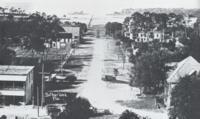 The view of Sutherland circa 1920 was taken from the cupola of the women's
dormitory building at Southern College. Looking down unpaved Florida Avenue
out over Sutherland bayou, with the Gulf beyond, one may see the wooden sidewalk
on which students could walk all the way out to Pig Island for picnics and "surf
bathing." Originally, the means of transportation down to the dock was a
mule-drawn "bob-tailed streetcar." The buildings in the foreground survive as
two of the last remaining structures from Palm Harbor's early days.
| Courtesy of the Wallace Collection. 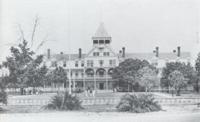
The old San Marino Hotel, with its towered ends and central cupola overlooking
Sutherland Bay, was occupied by Southern College in 1920 when this picture was
taken. This tranquil scene was interrupted on January 29, 1921, when a mysterious
fire destroyed the beautiful structure. Originating in Orlando in 1883, Southern
College was originally known as Wesleyan Institute. The college was moved to
Leesburg, where it became the Florida Conference College in 1886. After its move
to Sutherland (now Palm Harbor), it became known first as Florida Seminary in 1902,
and then as Southern College in 1906. At that time, Southern College was reputedly
the southernmost college in the United States. After the fire, E.T. Roux, owner
of the Clearwater Beach Hotel, offered his facility for the homeless college. The
facility burned there after one season, and the college was moved to Lakeland,
where it was named Florida Southern College. Courtesy of the Wallace Collection.
| 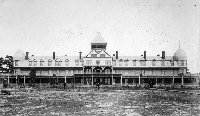
Hotel San Marino in Sutherland ca. 1893 just after completion of construction.
Notice the wheel barrow and the men still working on the fountain that used to be in the front courtyard of the hotel. Near the boardwalk in the distance is Hog Island, a favorite spot for the local.
Courtesy of Jeff Cannon.
| 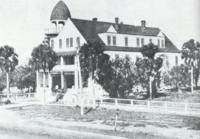
Once a hotel, the beautiful Gulf View Apartments, with its towered cupola overlooking
the Gulf, stood in the tiny town of Sutherland (later Palm Harbor) on the north
side of Florida Avenue across from Adair's Grocery Store. Long since torn down, it,
along with the Southern College building, represented Sutherland's grandiose dreams
which were never to be. Courtesy of the Sanders Collection.
| 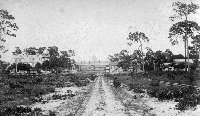
View of Sutherland and the Hotel San Marino from the boardwalk at the bay and Hog Island,
looking east on Florida Ave. You can also see the Gulf View Apartments on the left.
Courtesy of Jeff Cannon.
| 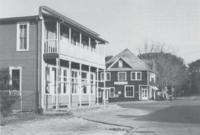
These are two of the last remaining historical structures in Palm Harbor (formerly
Sutherland) today. Courtesy of the Clearwater Chamber of Commerce.
| 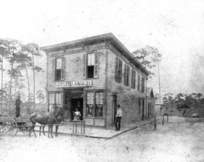
J.C. Craver's store in Palm Harbor (then 'Sutherland') in the late 1800's.
Craver was the first Worhsipful Master of the local Masonic Lodge (Sutherland Lodge No. 174 F.& A.M., founded 1908).
Photo courtesy of The Florida Photographic Collection.
| 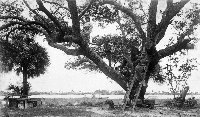
This photo was taken on Hog Island and shows the immense Live Oak Trees where the local residents would
gather for picnic and to enjoy the view of the bay. In this photo several town folk have climbed the huge Live Oak Tree where
the view must have been tremendous.
Courtesy of Jeff Cannon.
| 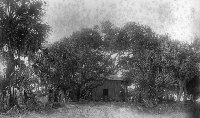
Another photo taken on Hog Island, which shows a local fisherman's shack that was built on the Island.
Two local fisherman are standing in front of the Hog Island shack with their children sitting in the door.
Courtesy of Jeff Cannon.
| 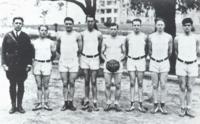
No, this isn't a German officer, but rather the South Florida Military Institute
coach (at Palm Harbor) proud of his 1926 Southwest Florida Championship team.
Courtesy of the Sanders Collection.
| 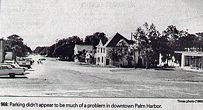
Downtown Palm Harbor, 1966
Florida Avenue from the West looking East
Sutherland Lodge is just left of center in the photo.
Photo courtesy of The St. Petersburg Times
| |
North Pinellas Historical Museum
a division of M&JB Investment Company (M&JB) of Palm Harbor.
Copyright © 1999- by M&JB. All rights reserved.